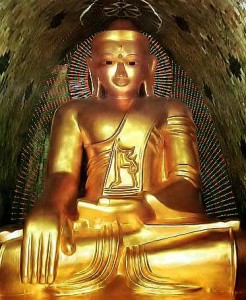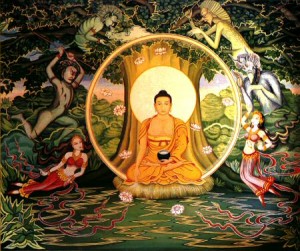The following is an excerpt from a teaching by Jetsunma Ahkon Lhamo called Commitment to the Path:
These two particular teachings about the preciousness of this human rebirth and the impermanence of all things samsaric are supposed to make us see, recognize and call to mind and to be mindful of the difference between what is ordinary and what is extraordinary. What is ordinary experiences birth and death. It doesn’t travel with you. It’s a product of samsara and its building blocks, which are delusion, and the senses, which are also deluded. And while this is what builds samsara (and this is nothing to feel comfortable in), once you identify that, you can also identify what is extraordinary. And what is extraordinary is the Buddha nature.
We think about the Buddha nature as it appears in the world as the ground, the method and the fruit. The ground is that the Dharma, Buddhism—the way that the Buddha enters into the world—always comes from the mind of enlightenment. Whenever the Buddha speaks, the Buddha speaks from enlightenment, from the Buddha nature that does not experience rebirth. All teachings in Dharma, then, arise from the foundation, the ground. All teachings in Dharma are expressed as the method, or path. One thing that distinguishes us from other religions is that we have method, real solid method and many different methods, to suit different karmic propensities. But the method is given rise by the Buddha nature, so the method and the Buddha nature are not only similar; they are the same taste, the same stuff. So the path is enlightened as well. The result, of course, is Buddhahood, liberation from ordinary death and rebirth and the realization of the primordial wisdom nature, that awakened state that the Buddha described. That’s the result—Buddhahood which arises from Buddhahood, which is Buddhahood and remains Buddhahood. The ground, the method and the result are indistinguishable.
So now we have identified what is impermanent. We have identified what is useless. Now we begin, because of that teaching, to identify what is extraordinary, what is of benefit. From that knowledge we can begin to make choices about how to practice our path. You can see how it would be difficult to make a real commitment without understanding that. It would be a fad for you, a thing.
Tibetan Buddhism is really kind of stylish right now. We’re in vogue, but that’s not how we should approach this. We have to approach it with eyes open. And believe me, as you get older, you’re going to realize that, just like the Buddha taught, our lives are like a waterfall rushing down a mountain. Oh, you might think, that’s not bad. Waterfalls last a long time, but don’t you get it? You’re looking at a condition. When you see a waterfall, you’re looking at a condition. The cup of water that falls from the top reaches the bottom in a heartbeat and we’re like that. We look at life and we think, oh, it’s constant. Been here for a while. Probably be here for a while. But that cup of water falls down so fast that we come to the point at the end of our lives and we wonder. We look in the mirror and we see ourselves. We have graying hair and like I said, everything is falling south and all these changes are happening. For me, I look in the mirror and here is this middle age woman and I go, how did that happen.? I am just a kid. I’m just learning something here. How did that happen? And that is the experience that we have. It goes that quickly.
And while life seems like a jewel to be enjoyed, we do not understand that if we spend our time enjoying it, it will be over in a flash and we will have gone to a precious continent and brought nothing back. And it’s not to say you shouldn’t enjoy it. I’m trying to enjoy my life, but I get the big picture. And that’s the thing we need to do here. We need to get the big picture. If we are in this place of great benefit and we have met with the teacher and met with the path, we must encourage ourselves to take advantage of this precious opportunity. I hope that you’ll think about this again and again and again.
Lord Buddha teaches us that all sentient beings are suffering, that all of samsara is pervaded with suffering, that we are wandering in cyclic existence helplessly. We are taught that all sentient beings are the same in their nature and the same in the fact that they all wish to be happy. Even when they do crazy things, they are trying to be happy, to feel good. And we realize while there is all this suffering, there is an end to this suffering and that end is liberation. And that’s the only good news in all of life.
© copyright Jetsunma Ahkon Norbu Lhamo All rights reserved.









